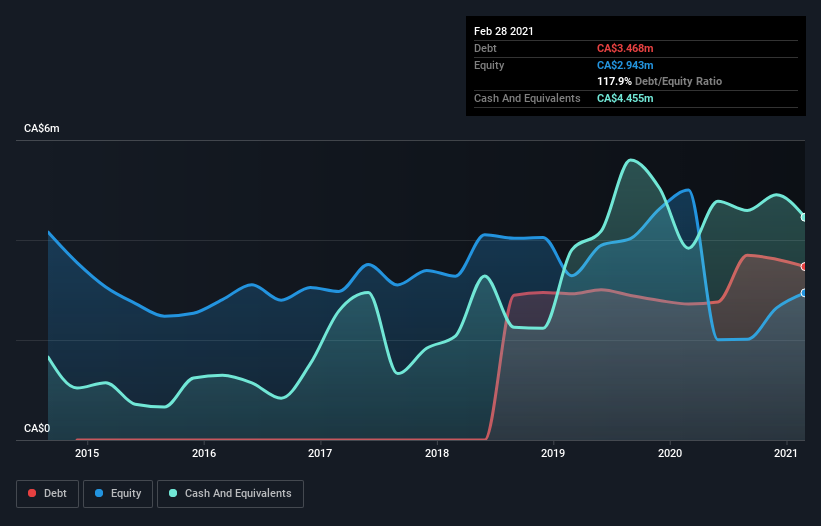Is Thermal Energy International (CVE:TMG) A Risky Investment?
Warren Buffett famously said, 'Volatility is far from synonymous with risk.' When we think about how risky a company is, we always like to look at its use of debt, since debt overload can lead to ruin. We note that Thermal Energy International Inc. (CVE:TMG) does have debt on its balance sheet. But should shareholders be worried about its use of debt?
When Is Debt A Problem?
Debt is a tool to help businesses grow, but if a business is incapable of paying off its lenders, then it exists at their mercy. Ultimately, if the company can't fulfill its legal obligations to repay debt, shareholders could walk away with nothing. However, a more usual (but still expensive) situation is where a company must dilute shareholders at a cheap share price simply to get debt under control. Of course, plenty of companies use debt to fund growth, without any negative consequences. When we think about a company's use of debt, we first look at cash and debt together.
Check out our latest analysis for Thermal Energy International
How Much Debt Does Thermal Energy International Carry?
You can click the graphic below for the historical numbers, but it shows that as of February 2021 Thermal Energy International had CA$3.47m of debt, an increase on CA$2.72m, over one year. But it also has CA$4.46m in cash to offset that, meaning it has CA$986.8k net cash.
How Strong Is Thermal Energy International's Balance Sheet?
The latest balance sheet data shows that Thermal Energy International had liabilities of CA$4.40m due within a year, and liabilities of CA$4.39m falling due after that. Offsetting these obligations, it had cash of CA$4.46m as well as receivables valued at CA$3.16m due within 12 months. So it has liabilities totalling CA$1.18m more than its cash and near-term receivables, combined.
Of course, Thermal Energy International has a market capitalization of CA$29.5m, so these liabilities are probably manageable. Having said that, it's clear that we should continue to monitor its balance sheet, lest it change for the worse. Despite its noteworthy liabilities, Thermal Energy International boasts net cash, so it's fair to say it does not have a heavy debt load! The balance sheet is clearly the area to focus on when you are analysing debt. But you can't view debt in total isolation; since Thermal Energy International will need earnings to service that debt. So if you're keen to discover more about its earnings, it might be worth checking out this graph of its long term earnings trend.
In the last year Thermal Energy International had a loss before interest and tax, and actually shrunk its revenue by 42%, to CA$14m. To be frank that doesn't bode well.
So How Risky Is Thermal Energy International?
We have no doubt that loss making companies are, in general, riskier than profitable ones. And we do note that Thermal Energy International had an earnings before interest and tax (EBIT) loss, over the last year. And over the same period it saw negative free cash outflow of CA$354k and booked a CA$2.7m accounting loss. Given it only has net cash of CA$986.8k, the company may need to raise more capital if it doesn't reach break-even soon. Overall, we'd say the stock is a bit risky, and we're usually very cautious until we see positive free cash flow. When analysing debt levels, the balance sheet is the obvious place to start. However, not all investment risk resides within the balance sheet - far from it. Be aware that Thermal Energy International is showing 4 warning signs in our investment analysis , and 1 of those doesn't sit too well with us...
If, after all that, you're more interested in a fast growing company with a rock-solid balance sheet, then check out our list of net cash growth stocks without delay.
This article by Simply Wall St is general in nature. We provide commentary based on historical data and analyst forecasts only using an unbiased methodology and our articles are not intended to be financial advice. It does not constitute a recommendation to buy or sell any stock, and does not take account of your objectives, or your financial situation. We aim to bring you long-term focused analysis driven by fundamental data. Note that our analysis may not factor in the latest price-sensitive company announcements or qualitative material. Simply Wall St has no position in any stocks mentioned.
Have feedback on this article? Concerned about the content? Get in touch with us directly. Alternatively, email editorial-team (at) simplywallst.com.

 Yahoo Finance
Yahoo Finance 